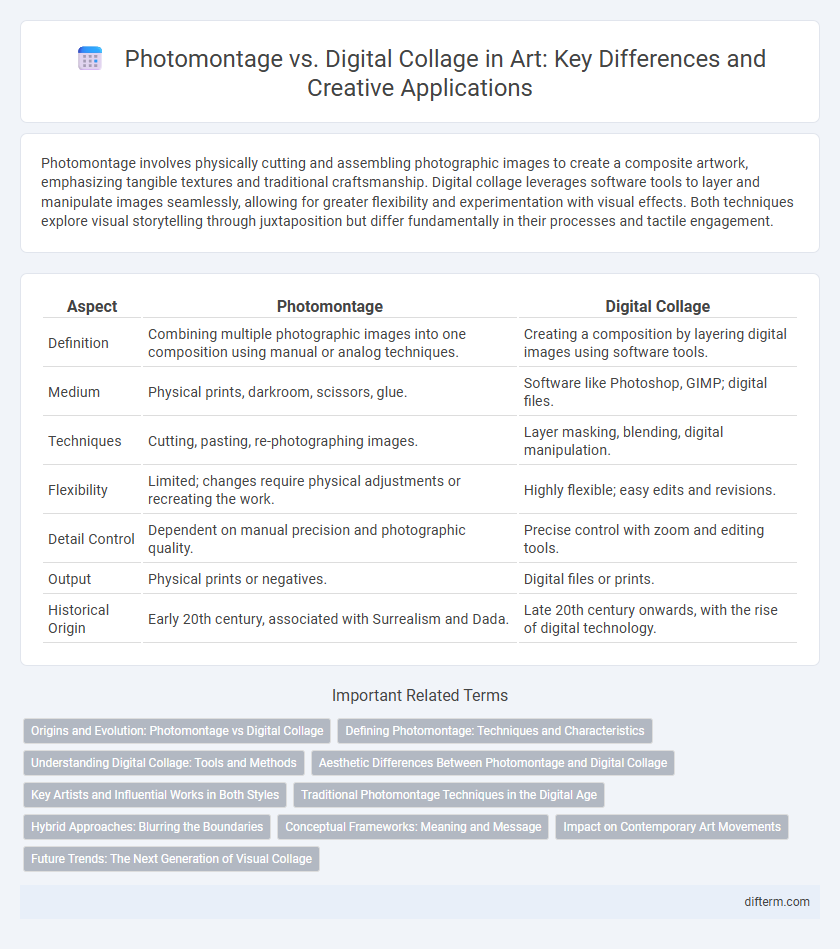Photomontage involves physically cutting and assembling photographic images to create a composite artwork, emphasizing tangible textures and traditional craftsmanship. Digital collage leverages software tools to layer and manipulate images seamlessly, allowing for greater flexibility and experimentation with visual effects. Both techniques explore visual storytelling through juxtaposition but differ fundamentally in their processes and tactile engagement.
Table of Comparison
| Aspect | Photomontage | Digital Collage |
|---|---|---|
| Definition | Combining multiple photographic images into one composition using manual or analog techniques. | Creating a composition by layering digital images using software tools. |
| Medium | Physical prints, darkroom, scissors, glue. | Software like Photoshop, GIMP; digital files. |
| Techniques | Cutting, pasting, re-photographing images. | Layer masking, blending, digital manipulation. |
| Flexibility | Limited; changes require physical adjustments or recreating the work. | Highly flexible; easy edits and revisions. |
| Detail Control | Dependent on manual precision and photographic quality. | Precise control with zoom and editing tools. |
| Output | Physical prints or negatives. | Digital files or prints. |
| Historical Origin | Early 20th century, associated with Surrealism and Dada. | Late 20th century onwards, with the rise of digital technology. |
Origins and Evolution: Photomontage vs Digital Collage
Photomontage originated in the early 20th century as a manual process combining multiple photographs to create surreal or political images, heavily utilized by Dada and Constructivist artists. Digital collage emerged in the late 20th century with the advent of computer graphics software, enabling artists to manipulate and blend digital images with greater precision and versatility. The evolution from photomontage to digital collage reflects technological advancements that expanded creative possibilities while maintaining a foundation in layering and juxtaposing visual elements.
Defining Photomontage: Techniques and Characteristics
Photomontage combines multiple photographs into a single composition, traditionally involving physical cutting and pasting to create seamless or surreal visual narratives. Techniques include layering, masking, and blending images to manipulate space, time, and perspective, often enhancing conceptual or political messages. Key characteristics involve the juxtaposition of disparate photographic elements, maintaining photographic realism while generating new meanings through visual synthesis.
Understanding Digital Collage: Tools and Methods
Digital collage utilizes software like Adobe Photoshop and Procreate to layer images, blending textures and colors with precision for innovative visual storytelling. Photomontage, traditionally involving physical cutting and assembling of photographs, has evolved into digital forms but retains its focus on juxtaposing photographic elements. Mastery of digital collage techniques includes using selection tools, masking, and blending modes to seamlessly integrate diverse digital assets into cohesive artworks.
Aesthetic Differences Between Photomontage and Digital Collage
Photomontage often emphasizes realistic integration of photographic elements to create seamless, surreal compositions, highlighting texture and depth through precise layering. Digital collage leverages software flexibility, allowing for more abstract, fragmented aesthetics with diverse media manipulation and vibrant color adjustments. The aesthetic differences lie in photomontage's focus on cohesive visual narratives versus digital collage's exploratory, experimental approach to visual form.
Key Artists and Influential Works in Both Styles
Photomontage pioneers like Hannah Hoch and John Heartfield revolutionized art by combining photographic elements to create politically charged, surreal imagery, exemplified in Hoch's "Cut with the Kitchen Knife." In digital collage, artists such as Eugenia Loli and David McLeod utilize advanced software to blend photographic and graphic elements seamlessly, producing vibrant, contemporary compositions like Loli's "Space Is the Place." Both styles emphasize layering and juxtaposition, evolving from analog techniques to digital innovation, shaping the visual narrative in modern art.
Traditional Photomontage Techniques in the Digital Age
Traditional photomontage techniques, involving the manual cutting, layering, and reassembling of photographic prints, maintain a tactile authenticity that digital tools often lack. Artists who employ physical photomontage prioritize texture, depth, and the serendipitous imperfections that arise from hands-on manipulation. Despite the rise of digital collage methods using software like Photoshop, traditional photomontage continues to thrive as a distinct, expressive art form that emphasizes materiality and craftsmanship.
Hybrid Approaches: Blurring the Boundaries
Hybrid approaches in art merge photomontage and digital collage techniques, creating innovative visual narratives that blur traditional boundaries. These methods combine photographic fragments with digitally manipulated elements, enhancing depth and texture while challenging perceptions of reality. Artists leveraging hybrid strategies expand the potential of mixed media, fostering dynamic compositions that transcend conventional categorization.
Conceptual Frameworks: Meaning and Message
Photomontage and digital collage both manipulate images to communicate complex meanings, yet photomontage traditionally relies on analog processes that emphasize materiality and historical context, conveying layered narratives through physical juxtaposition. Digital collage harnesses software tools to blend diverse visual elements seamlessly, expanding the conceptual framework by incorporating digital symbolism and intertextuality. The message in photomontage often critiques sociopolitical realities through fragmented imagery, while digital collage explores identity and virtual experience, reflecting contemporary cultural tensions.
Impact on Contemporary Art Movements
Photomontage, emerging in the early 20th century, revolutionized Dada and Surrealism by combining disparate photographic elements to challenge reality and provoke political commentary. Digital collage, enabled by advanced software tools like Adobe Photoshop, expands artistic possibilities through layering, manipulation, and integration of multimedia components, influencing contemporary movements such as Postmodernism and New Media Art. Both techniques disrupt traditional visual narratives, fostering experimentation and redefining boundaries within contemporary art.
Future Trends: The Next Generation of Visual Collage
Emerging technologies in photomontage and digital collage are driving new forms of immersive, interactive art experiences through augmented reality (AR) and virtual reality (VR) integrations. AI-powered tools enable artists to generate complex, multilayered compositions with unprecedented precision and speed, pushing the boundaries of visual storytelling. Blockchain and NFTs are revolutionizing the ownership and distribution of digital collages, fostering innovative marketplaces and broadening the global reach of collage artists.
photomontage vs digital collage Infographic

 difterm.com
difterm.com